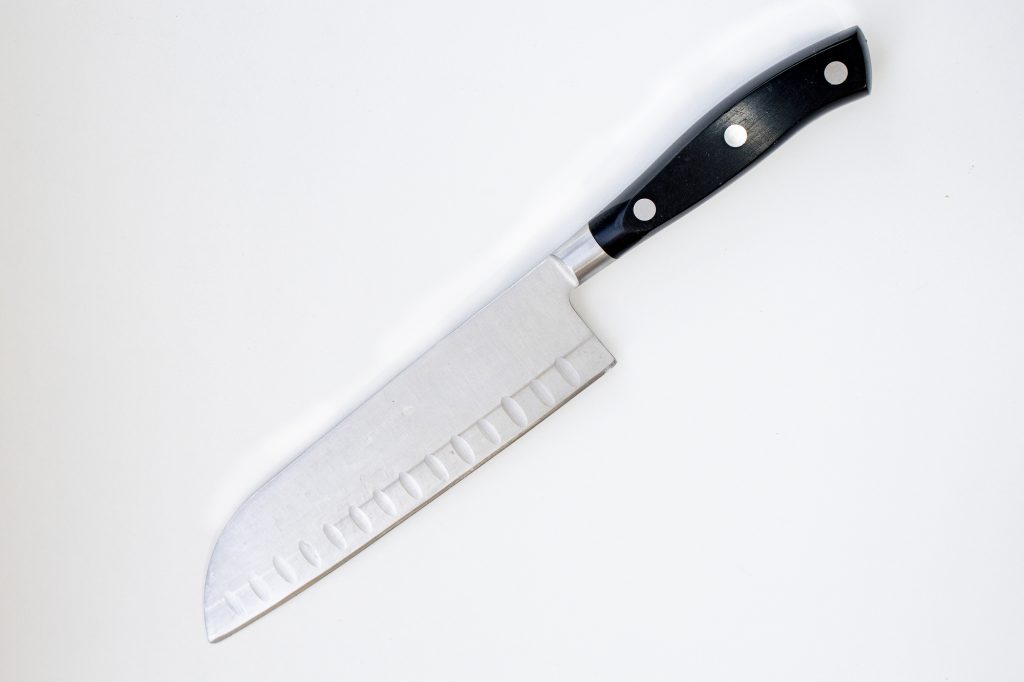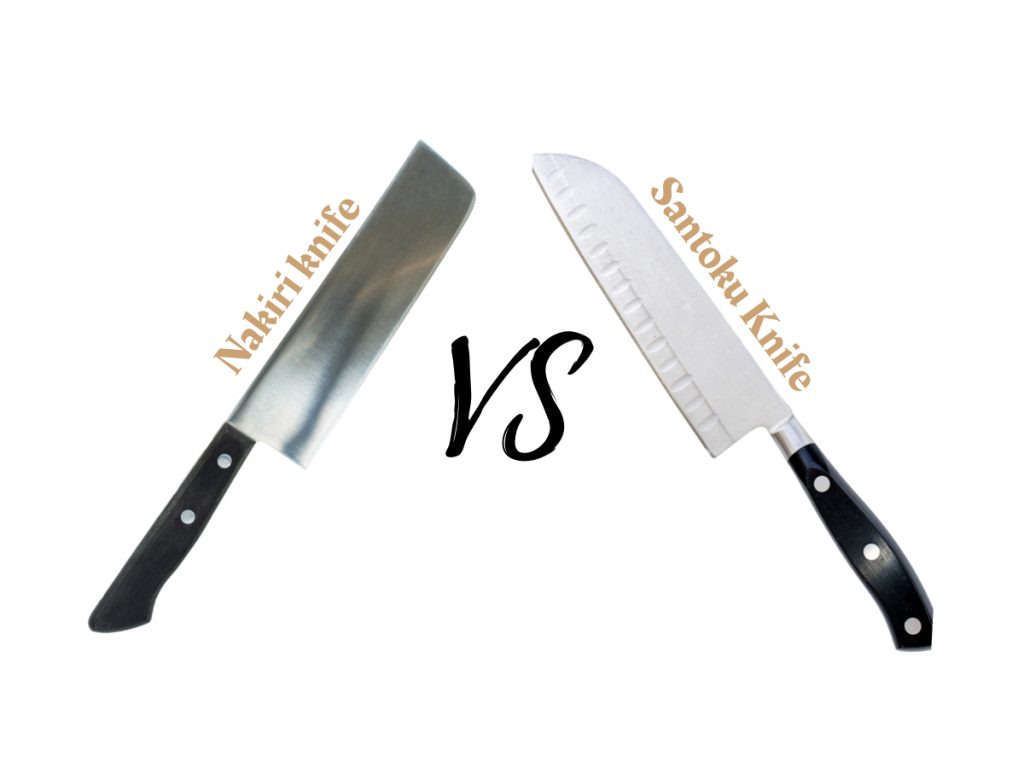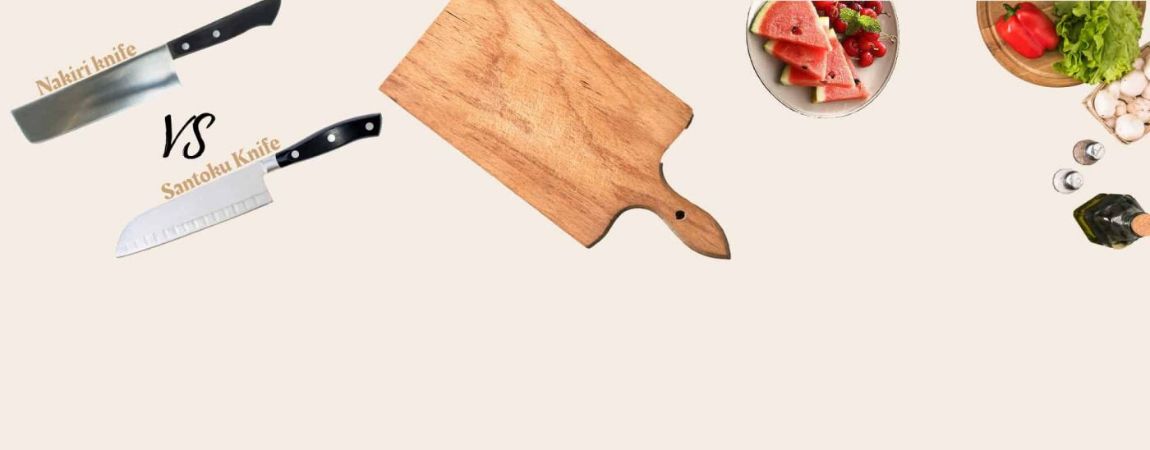Developing your skills as a chef is about so much more than just practicing regularly. If you don’t understand the purpose of each tool you’re using, you run the risk of entrenching poor technique or even injuring yourself. On this page, we’ll be exploring the Santoku VS Nakiri debate.
We’ll explore both types of knives, discussing their purposes, what makes them different from one another, and how to decide which option might work best for you in the kitchen. Read on to up your knife knowledge.
Santoku Overview
Santoku knives are Japanese in origin and are trusted by countless chefs around the world. Their name provides a vital clue about their purpose. Santoku can be translated as ‘three virtues.’
For Santoku knives, these three virtues are chopping, dicing, and mincing. For the right chef, a Santoku blade can be a fantastic general-purpose kitchen tool. Some people use it in place of a ‘traditional’ chef’s knife.

Santoku Shape
A comparatively narrow edge and a ‘sheep’s foot’ shape are characteristic of Santoku knives. This shape explains the lack of a sharpened tip – most options feature a sloping line at the end of the blade.
For some people, these factors work in tandem to produce a knife that is surprisingly versatile and effective in the kitchen.
Santoku History
This type of kitchen knife first became popular in the 20th century after the second world war. An earlier type of cleaver called Nakiri was beginning to be replaced by this newer style of tool.
Today, both types of knives are popular among home and professional chefs. We explore Nakiri knives later in this article.
Santoku Uses
- The three virtues – chopping, dicing, and mincing
- General kitchen prep
- Cutting less dense meats
- Preparing vegetables
- Very thin slices of food
Santoku Basic Stats
- Blades are typically 5-8 inches long
- A blade thickness somewhere around 0.06 of an inch – single bevel
- Between 58 and 60 HRC
Nakiri Overview
This older style of Japanese knife is closer to a cleaver in terms of overall appearance. It’s best used with an up-and-down motion rather than the rocking motion that’s typical of most western chef’s knives.
Nakiri knives are great for thin, delicate slices of food but can also be used to tackle denser cuts of meat with ease.

Nakiri Shape
Nakiri usually features a rectangular blade with a straight edge and a rounded tip. They’re also comparatively lightweight and thin which makes them an excellent companion for a wide variety of tasks in the kitchen. A good quality Nakiri knife will feature a robust, well-balanced handle that feels great in the hand.
Nakiri History
During the Edo era in Japan, it was against the law to eat any animal with four legs. This meant that vegetables, rice, and fish became staples of the nation’s diet. From this historical context, Nakiri knives emerged.
This makes them a fantastic option for preparing many traditional types of Japanese cuisine.
Nakiri Uses
- Thin delicate slices of food
- Tackling denser cuts of mean
- Traditional Japanese meals
- Even, clean slices that happen quickly
Nakiri Basic Stats
- Most blades are 5-7 inches long
- Blades between .06″ and .10″ thick – double-edged
- Between 59 and 62 HRC
Nakiri VS Santoku – How They’re Different?
The main difference to consider between Nakiri VS Santoku is how you’ll be cutting with them. Santoku knives work best with a rocking motion. This will feel most familiar if you’ve only ever used western-style knives before.
Nakiri knives, on the other hand, are best used with an up-and-down motion. If you know you need a knife that can handle denser meats, a Nakiri knife might be best.
Both types of knives can serve very well as an alternative to an all-purpose chef’s knife.
Cleaver | Santoku | Nakiri |
Blade Length | 5-8 inches | 5-7 inches |
Blade Thickness | 0.06” – single bevel | Between 0.06″ and 0.10″ – double-edged |
Flexibility | Higher than Nakiri but relatively low | Low |
HRC | 58-60 | 59-62 |
Main Purpose | Chopping, dicing, and mincing | Clean, thin, fast cuts. Meat prep |

Shape
If it features a sheep’s foot shape without a pointed tip and a single-bevel edge – it’s a Santoku.
If it’s got a rectangular shape with a curved tip and a double-edged blade – you’re looking at a Nakiri.
Motion
For Santoku knives, a rocking motion works best. With Nakiri knives, an up-and-down motion is the best way to go.
Which One Should I Choose?
If you’re most familiar with western-style knives, it’s best to go with a Santoku knife, unless you’re looking to try something new.
If you know you want your all-purpose knife to also work with denser meats, choose Nakiri. Both knives are fantastic for preparing Japanese food, but Nakiri in particular can be great for those super-clean cuts.
Santoku Recommendation
Looking for a Santoku recommendation? This is our favorite Santoku knife in 2022 – Mercer Culinary M20707 Genesis 7’’ Santoku Knife.
Read our full review here.
It’s a masterclass in performance and value for money.
Click here to find the best Santoku knives.
Nakiri Recommendation
As for Nakiri options, we think this is the best one to go for – Tojiro Nakiri Knife F-502.
It’s exceptionally sharp and well-balanced.
Check out our review of the best Nakiri knives.
Final Thoughts
We hope this article has helped clear up the Santoku VS Nakiri knives question. Both can be fabulous chef’s knives but require different hand motions to be used effectively – rocking VS up and down.
Whichever knife you choose, we hope it serves you well for many years to come!




Post Your Thoughts